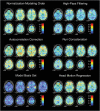On the plurality of (methodological) worlds: estimating the analytic flexibility of FMRI experiments
- PMID: 23087605
- PMCID: PMC3468892
- DOI: 10.3389/fnins.2012.00149
On the plurality of (methodological) worlds: estimating the analytic flexibility of FMRI experiments
Abstract
How likely are published findings in the functional neuroimaging literature to be false? According to a recent mathematical model, the potential for false positives increases with the flexibility of analysis methods. Functional MRI (fMRI) experiments can be analyzed using a large number of commonly used tools, with little consensus on how, when, or whether to apply each one. This situation may lead to substantial variability in analysis outcomes. Thus, the present study sought to estimate the flexibility of neuroimaging analysis by submitting a single event-related fMRI experiment to a large number of unique analysis procedures. Ten analysis steps for which multiple strategies appear in the literature were identified, and two to four strategies were enumerated for each step. Considering all possible combinations of these strategies yielded 6,912 unique analysis pipelines. Activation maps from each pipeline were corrected for multiple comparisons using five thresholding approaches, yielding 34,560 significance maps. While some outcomes were relatively consistent across pipelines, others showed substantial methods-related variability in activation strength, location, and extent. Some analysis decisions contributed to this variability more than others, and different decisions were associated with distinct patterns of variability across the brain. Qualitative outcomes also varied with analysis parameters: many contrasts yielded significant activation under some pipelines but not others. Altogether, these results reveal considerable flexibility in the analysis of fMRI experiments. This observation, when combined with mathematical simulations linking analytic flexibility with elevated false positive rates, suggests that false positive results may be more prevalent than expected in the literature. This risk of inflated false positive rates may be mitigated by constraining the flexibility of analytic choices or by abstaining from selective analysis reporting.
Keywords: analysis flexibility; data analysis; fMRI; false positive results; selective reporting.
Figures







References
LinkOut - more resources
Full Text Sources

